In the past few years, online shopping has experienced a phenomenal transformation. Not only has it gotten faster and simpler, but also been filled with an unlimited number of choices. With this transformation, customer expectations have gone sky-high as well. Today's consumers demand not only smooth but personalized and quick convenience. They demand this high level of service at each step of their experience.
To meet these escalating demands, top e-commerce players are adopting artificial intelligence services. As part of the evolving ecommerce personalization and AI ecommerce movement, AI is no longer just a behind-the-scenes tool; it’s transforming how these players interact with customers, making the interactions intelligent and rich.
With the force of AI, businesses can customize ecommerce personalization experiences in real time. They can react to customer requirements at the moment while streamlining their operations. This creates increasingly intimate relations with customers that stretch far beyond a single transaction. When done correctly, AI creates trust and drives long-term loyalty.
In the pages that follow, you'll see how artificial intelligence for ecommerce makes customer-focused shopping easy. You'll see real-world examples, actionable advice, and open business opportunities. The idea is straightforward: the more your customers feel noticed and appreciated, the more they'll be loyal to you.
Why Customer-Centricity Matters in E-commerce
The key to successful e-commerce lies in a very simple principle. Your business has to be customer-centric. Whatever you do, starting from design to delivery, has to be for them, about them, and around them. This means grasping the true desires of your customers. This entails observing their buying behavior, the issues they experience, and the things that draw them back time and again.
When you do this, you begin building personalized ecommerce experiences. Your store is more memorable and creates stronger emotional connections. In a crowded online marketplace, that's how you differentiate. Customer-focused brands are likely to experience increased retention and repeat business. Happy customers are likely to spread the word, creating positive word-of-mouth and reviews. Over the long term, it becomes one of the best growth weapons.
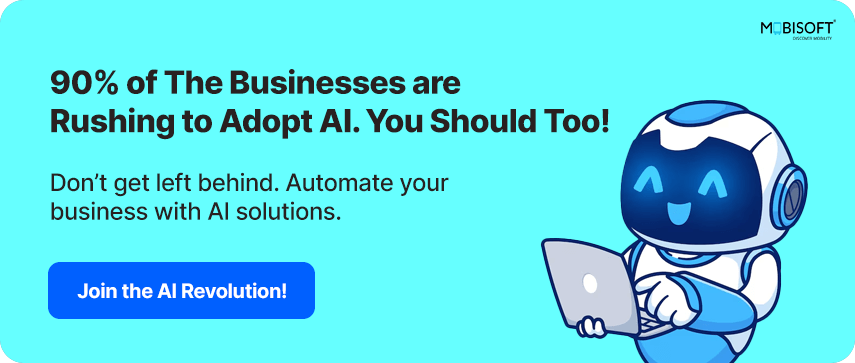
The Role of AI in Building Customer-Centric Strategies
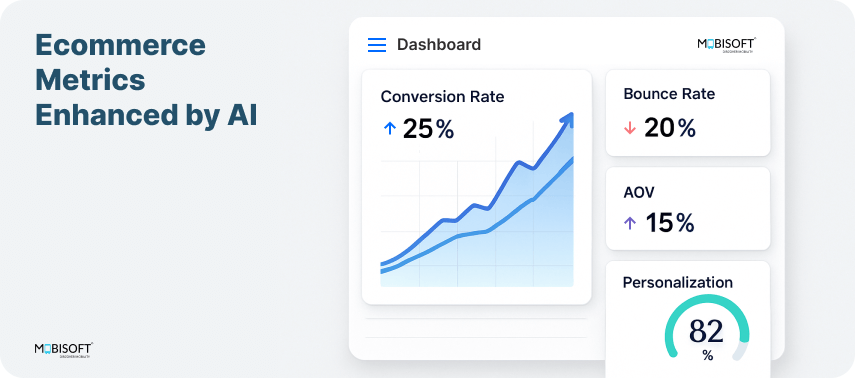
But important. AI makes it possible at scale. By examining massive volumes of customer interactions in real time, AI‑powered analytics allow brands to truly comprehend what drives certain behavior. Every click, AI product search, purchase, and even delay is translated into insight.
Such AI-powered ecommerce analytics enable brands to move beyond one-size-fits-all messaging. AI is the answer to creating customized experiences that react to users' needs in real-time. From optimizing an email campaign to ecommerce automation like personalizing homepage banners or suggesting the ideal product, AI makes every interaction relevant and personal.
The reward? Increased customer trust and loyalty. When customers are heard, they tend to stick around, return, and recommend.
Here’s how customer‑centric ecommerce AI helps brands become truly customer-centric:
Deepen Customer Understanding
AI monitors and reports on customers in real-time. It identifies what a user likes, how they shop, and what influences their decisions.
Deliver Hyper-personalized Experiences
AI adapts experiences as individuals interact. It changes content, presents, and AI‑driven product recommendations for online stores dynamically, so each experience is unique.
Build Lasting Relationships
Through ongoing learning from every encounter, AI allows brands to speak more genuinely. This develops memories that fuel loyalty over time.
Advanced technologies like AI-driven omnichannel personalization help deliver tailored experiences across web, mobile, and offline channels.
Source: Customer-Centric AI Strategies and Why You Need One
Key AI Applications for Customer-Centric E-commerce
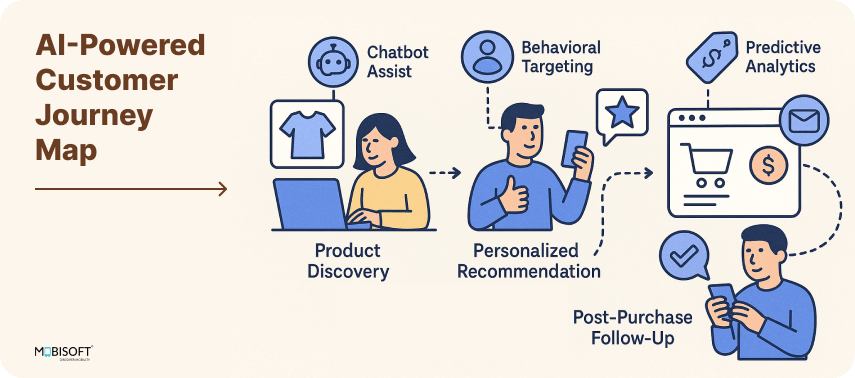
AI improves all stages of the customer journey. AI ecommerce platforms vs manual solutions show a significant edge in efficiency and scale. AI helps from the point where a customer starts to shop, even before they make a purchase. Online shops use AI to predict the requirements of their customers. They also use it to answer quickly and deliver more customized experiences. Let us see the key uses of AI that allow brands to focus on their customer.
Hyper-Personalized Recommendations
AI-driven product recommendations are far more sophisticated than "customers also bought." These engines scan browsing patterns, buying histories, and tastes to make highly relevant suggestions.
Example:
Amazon attributes its recommendation engine with producing approximately 35% of its revenues, which is dynamically updated in real time based on user behavior.
Benefit:
Individuals feel understood and heard. This enhances both the chances of purchase and satisfaction on the part of customers. This approach aligns perfectly with AI personalization software pricing models that scale with growing customer needs.
Learn more about how AI product recommendations in ecommerce enhance the customer journey and drive conversions.
Dynamic Content & Landing Pages
Static sites are a thing of the past. Now, AI ecommerce tools can respond in real-time. AI enables banner and product catalog, promotion and landing page, and anything else you can think of , personalization based on a visitor's behavior during a session.
Example:
Tools like Wisepops and Nosto allow brands to do this with ease. They deliver personalized content based on an individual's location, device, and history with the store.
Why does it matter?
When audiences see content that's pertinent to them, they're more likely to spend, click through more, and buy.
AI-Powered Customer Support
Customers today want answers immediately. AI chatbots for ecommerce and virtual assistants can do that, anywhere, anytime. These bots employ natural language processing (NLP) to comprehend questions and provide human-like answers. Sophisticated AI can notice that a customer is struggling or is about to abandon a cart and step in.
Proactive Support
AI chatbots for ecommerce customer service can trigger discount offers, share content, or pass the conversation to a live agent using sentiment analysis.
Continuous Learning
They learn to improve with each use, gaining knowledge from user behavior and feedback and becoming more intelligent and useful day by day.
Predictive Analytics & Proactive Engagement
AI enables online shops to stay ahead of the game when it comes to customer action. It uses predictive analytics, analyzing browsing history, previous purchases, and user activity. Based on this, brands can anticipate what a consumer will require next.
This enables AI ecommerce strategies to be proactive. They can offer customized promotions, send useful reminders, or alter product display ,all without a customer ever making a request.
Cart Abandonment
If a buyer abandons the cart, AI does not fall behind. It sends personalized follow-up messages or promotions. The reminders encourage users to return and finalize the purchase. Implementing abandoned cart recovery in such a way boosts conversion and gets lost sales back on track.
Inventory Management
AI helps retailers to better manage their stocks. Based on historical sales data and current customer behavior, it predicts demand patterns. This enables AI inventory optimization, helping companies avoid stockouts as well as overstocking. So, they can reduce expenses and offer best-sellers when customers are looking for them.
Visual & Voice Search
AI-powered product search tools are transforming how consumers shop online. They no longer need to type detailed descriptions.
Visual Search
Shoppers can take a picture of something they spotted. AI looks at the image in an instant and shows them similar products from the store. This accelerates product discovery and makes it more engaging.
Voice Search
Voice search enables users to speak naturally. You can tell the platform, "Show me black shoes under $100," and it gets your command. It responds immediately with correct results.
Example:
This is a handy feature that makes it extremely easy to search, particularly for mobile users and smart device shoppers.
Dynamic Pricing & Inventory Optimization
AI tracks competitor prices, demand fluctuations, and market signals in real time. Based on this, it executes dynamic pricing AI adjustments instantly.
Example:
Amazon employs a dynamic pricing engine that processes thousands of data points every second. The platform dynamically changes prices instantly to remain competitive as well as safeguard profit margins. The brands employing this approach can engage more consumers and sell more strategically.
Better Inventory
Planning AI also facilitates easy management of stock by businesses. It anticipates what will be needed and suggests how much to hold. This avoids storage fees for waste and maintains the best-selling items in stock. Customers receive what they require, and businesses run more efficiently, one of the strongest benefits of AI in ecommerce today.
Source: AI in Retail and E-Commerce: 30 Examples to Know
Real-World Success Stories of AI in Ecommerce Personalization

Amazon
AI drives Amazon's recommendation engine, voice shopping with Alexa, and automation in their warehouses, generating conversions, improving operational efficiencies, and ultimately enhancing the customer experience through AI ecommerce strategies.
Sephora
Sephora employs AI for virtual try-ons and smart product recommendations. Consumers get smarter and more ecommerce personalization, and can see the product in action, leading to engagement and conversion.
Stitch Fix
AI-powered algorithms leverage style preferences and feedback to provide personalized fashion options to consumers. This increases satisfaction and helps manage inventory effectively with AI inventory optimization.
H&M
H&M applies artificial intelligence for ecommerce to forecast demand and customize marketing campaigns to personal tastes. This reduces stockouts, minimizes waste, and increases customer interaction.
Walmart
AI enables Walmart's supply chain, dynamic pricing AI, and personalization. The result: better inventory management, more satisfying shopping experiences, and more efficiency, online or in-store.
These brands demonstrate how successful AI implementation for ecommerce can elevate personalization and operational efficiency.
Source: Case Studies: E-Commerce Success Stories with AI
Best Practices for Implementing AI Ecommerce Personalization Tools
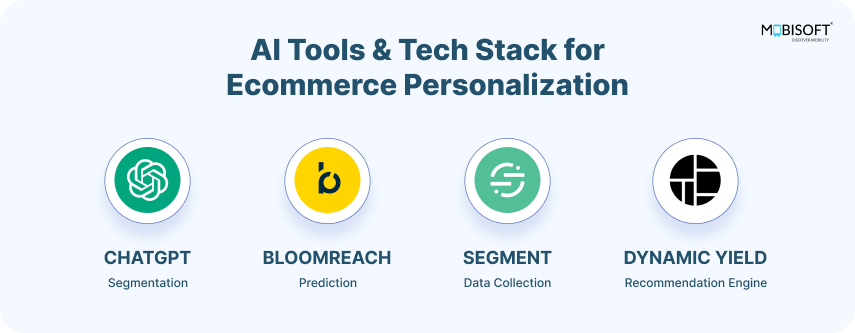
Ideally, AI should be implemented in the e-commerce business with planning and strong foundations. It is important to first set clear objectives while also establishing a qualified team. Second, data at the source level is critical.
Utilize quality data and select tools that enhance options in your existing stack, especially AI personalization software pricing options that fit your scale, without incorporating tools that require cumbersome integration. Third, introduce new features in small pieces, re-evaluate performance at all stages, and keep the customer informed throughout the AI ecommerce process.
Define Clear Objectives
The process starts by establishing targets and the metrics that will determine success. Before going down the path of implementing AI, you must have a clear idea of the outcomes you want to achieve. Increasing customer satisfaction by improving average order value and lowering fulfillment costs, are standard goal. However, one must also establish measurable goals such as achieving 10% increased conversions or reducing the volume of support requests by 20%. These goals will determine your AI ecommerce strategy and dictate what tools it plans to utilize. In short, specific goals will keep the team focused and aligned in getting the work completed.
Invest in High-Quality Data
Strong AI outcomes begin with accurate data. Audit your systems to tocapture the right signals, customer segments, previous purchases, and behavior patterns. Purify your data by eliminating duplicates and filling in missing fields. Your models will develop better product recommendations, predictions, and surprises when trained on accurate, complete data. Clean, rich data also helps in improving AI product search and dynamic optimization.
Integrate Seamlessly
Don't use AI software to create silos. Use AI ecommerce platforms that integrate effortlessly via API or middleware into your existing mission-critical systems, ERP, CRM, CMS, etc. Real-time data exchanges retain context. With context, personalization takes into account the customer's loyalty, return history, or abandoned cart when suggesting recommendations or promotions. Integration also creates a better user and team experience by enabling AI-powered ecommerce analytics and smoother data flows between siloed systems.
Start Small, Scale Fast
Select a feature to test, i.e., an AI product recommendation platform or FAQ bot. Deploy and monitor the outcome and learn from your users. If your small test goes well, you can deploy to other features, i.e., dynamic pricing AI and inventory forecast. Testing small minimizes risk and aligns well with ecommerce automation goals, letting you test and iterate your approach before scaling.
Monitor and Optimize
Your AI assets' behavior must be monitored at all times. You must track performance metrics like product recommendation click-through rates, satisfaction levels of customers with chatbots, and repeat order deviations. These must be set against your original goals. Use this information to optimize your models and algorithms, as well as react to changing consumer trends. The secret to long-term optimization lies in continuous fine-tuning and feedback from AI-powered analytics and user behavior.
Prioritize Privacy and Ethics
Keep customers' data wherever they are. Public key cryptography can be employed. Role-based access is a best practice requirement. You should have well-defined retention policies. Your AI ecommerce platform needs to be GDPR and CCPA compliant. Test your models frequently for undesirable racial and gender biases. Ethical artificial intelligence for ecommerce creates trust, as it is a sustainable competitive strength.
By following best practices, businesses can build scalable and personalized ecommerce solutions that not only enhance customer engagement and also drive measurable growth.
Challenges of AI in Ecommerce and How to Overcome Them
Every AI project faces challenges. Anticipate these standard challenges and bring solutions to keep projects on track. Address each challenge head-on to ensure your AI ecommerce efforts deliver genuine business value.
Data Privacy & Security
Utilize end-to-end encryption and secure cloud storage. Employ stringent multi-factor authentication. Present open privacy policies that are transparently disclosed, thoroughly explaining data collection and practices. Conduct regular security audits and third-party penetration testing to protect AI e-commerce platforms vs manual systems.
Integration Complexity
Use modern APIs and middleware like Mulesoft or Zapier. Begin with point-to-point integration for top-priority tools. Then, create a centralized data hub to make it easier to connect in the future and reduce technical debt, aligning better with customer-centric ecommerce AI implementations.
Change Management
Engage stakeholders from day one. Provide experiential learning to demonstrate how AI automates routine work and enables employees to perform strategic work. Demonstrate quick wins to generate momentum. Reward team members driving adoption and recognizing the benefits of AI in e-commerce.
Bias and Fairness
Audit data sets for representative coverage across demographics. Use bias detection tools like IBM AI Fairness 360. Retrain models with balanced data or reform parameters to fix biased results. Practice transparency by logging model decisions to ensure your AI ecommerce applications are fair and unbiased.
In order to navigate challenges, businesses can benefit from frameworks and insights shared in trusted resources.
Source: Challenges of Implementing AI in the eCommerce Industry
FAQs on AI Ecommerce Strategy and Tools
Q: How does AI personalize the e-commerce experience?
A: AI analyzes individual behaviors, preferences, and context to deliver tailored recommendations, content, and offers in real time, creating a unique ecommerce personalization journey for every customer.
Q: What are the most impactful AI tools for customer-centric e-commerce?
A: Recommendation engines, AI chatbots for ecommerce, predictive analytics, visual/voice search, and dynamic pricing AI are among the most effective.
Q: Can AI improve customer support?
A: Yes. AI chatbots for ecommerce customer service provide instant, 24/7 support, proactively solve problems, and continuously learn to enhance service quality.
Q: How do I measure the ROI of AI in e-commerce?
A: Track metrics like conversion rates, average order value, customer retention, support response times, and operational cost savings to evaluate your AI ecommerce strategy.
Conclusion & Action Steps for AI-Driven Ecommerce Personalization
AI is transforming e-commerce by amplifying customer-centric strategies. Brands now offer personalized suggestions that are akin to a one-on-one conversation. They regularly update site content in real time and utilize AI chatbots for e-commerce that react instantaneously. Forecasting analytics enable teams to forecast demand, control inventory, and roll out promotions at the right time.
Every purchase is an opportunity to bond. The system knows what every buyer prefers and recommends accordingly. It even foresees needs ahead of time. That kind of personal attention, driven by AI-powered analytics. instills trust in individuals and turns first-time buyers into loyalists of the brand.
Partner with Mobisoft Technologies to integrate these AI ecommerce functionalities into your store. Our e-commerce development services are designed to achieve your goals and integrate seamlessly into your existing processes. Our platforms grow with you.
Reach out to us today. We'll show you how AI-powered suggestions, dynamic personalization, and real-time data strategies can improve your e-commerce experience and drive measurable outcomes.
Citations:
- Revolutionize Your Brand with a Customer-Centric AI Strategy
- Top use cases for AI in Ecommerce | IBM
- How AI can improve customer experience in e-commerce
- Case Studies: E-Commerce Success Stories with AI
- AI in Retail and E-Commerce: 30 Examples to Know | Built In
- How AI Is Changing Ecommerce Personalization
- 20+ AI Tools for Ecommerce to Grow Your Business in 2025
- How AI is Enhancing Customer Engagement in E-Commerce
- AI in ecommerce: Everything you need to know (Use cases + best practices) | Sendbird
- 10+ Ways to Use AI in eCommerce to Redefine Your Business with Examples
- How best to leverage AI in eCommerce personalization | Instant
- AI in Ecommerce: How Is It Transforming Customer Experience
- AI for Ecommerce: How It’s Transforming the Future
- AI in E-commerce Support: Transforming Customer Experience
- Best AI Use Cases in E-commerce (Top Examples)
- AI in Customer Experience: A Game Changer for E-commerce
- Next-Level Ecommerce: AI's Secret Weapon For Personalized Experiences
- 8 AI Tools for Ecommerce [2025]
- The Impact of AI on Customer Engagement
- AI & ML in eCommerce: 10 Benefits, Use Cases, and Best Practices
- https://www.helloroketto.com/articles/ecommerce-personalization
- AI in E-commerce: Benefits, Challenges & Strategies
- AI-Powered Personalization in E-commerce with Case Studies and Benefits
- The Role of AI in Building Customer Centric Business Model | Millipixels
- AI in e-commerce case studies: Transforming digital retail
- Customer Centric Solutions and Best Strategy in 2025
- Using AI to Create Customer-Centric Business Strategies - Ekimetrics
- 14 Best Examples of AI in eCommerce [+ Use Cases]
- 15 Powerful Use Cases & Examples of AI in E-commerce Marketing
- Customer Centric Practices With AI
- AI in e-commerce: Examples and best practices | Bazaarvoice


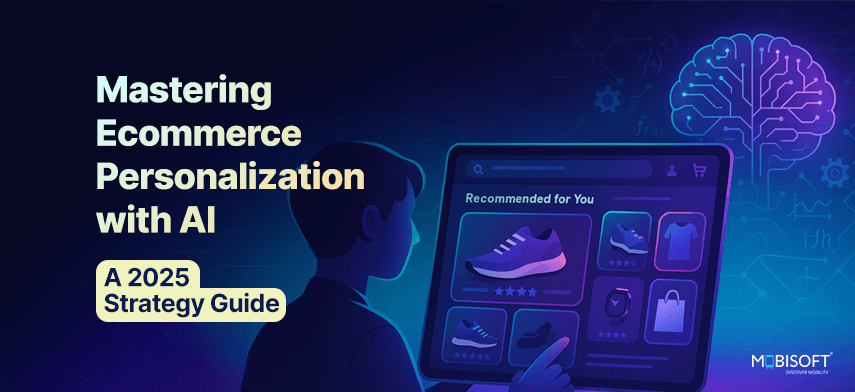


 July 2, 2025
July 2, 2025


